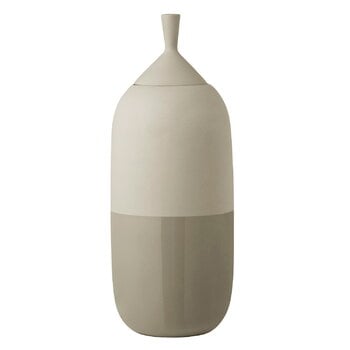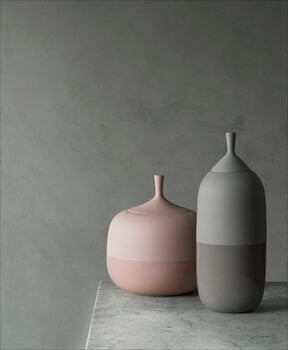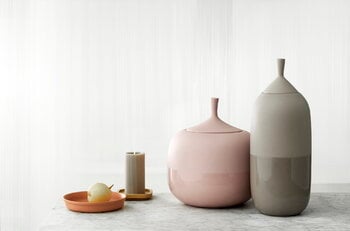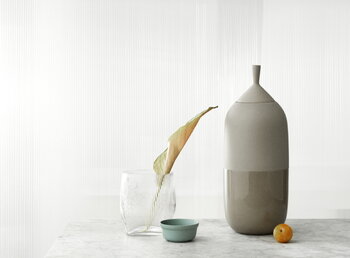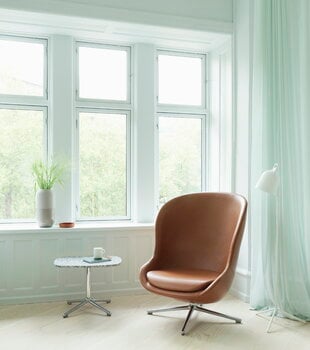Normann Copenhagen’s Pepo jar resembles a pumpkin or squash; the name actually comes from a word meaning just those. Made of porcelain, the two-toned surface of the jar is achieved by glazing only the lower half of the jar. The upper part and lid have a lovely, organic, unglazed surface. Designed by Daniel Debiasi and Federico Sandri, the delightful jar can also be used as a vase.
Pepo jar 48 cm, grey
Normann Copenhagen
Description
Normann Copenhagen’s Pepo jar resembles a pumpkin or squash; the name actually comes from a word meaning just those. Made of porcelain, the two-toned surface of the jar is achieved by glazing only the lower half of the jar. The upper part and lid have a lovely, organic, unglazed surface. Designed by Daniel Debiasi and Federico Sandri, the delightful jar can also be used as a vase.
Product details (7)
- Material
- Ceramic; part matt, part glazed
- Colour
- Grey
- Height
- 48 cm
- Diameter
- 18 cm
- Weight
- 2.9 kg
- Notes
- Glazed on the inside, so the jar can contain water.
- Care instructions
- Not suitable for dishwasher. Clean with damp cloth.
- Product ID
Designer
Daniel Debiasi and Federico Sandri are an Italian designer duo who founded the design studio Debiasi Sandri in 2010. Based in Verona and Bolzano, they work within a various fields of design ranging from objects to spaces. Their products are often results of experiments with different materials and are always connected to a bigger picture. Debiasi and Sandri have received many international design awards including the Plus X Award and iF Design Award.
View all productsReviews (0)
Sustainability
The Product Sustainability Framework, our criteria of sustainable design, helps you find the most sustainable products in our selection. Read below which sustainability criteria this product has met.
Working conditions & labour 7/9
-
Equal opportunities for all employees
-
Commitment to UN Global Compact, fair compensation for all employees
-
Corporate responsibility requirements defined and communicated for suppliers
-
Systematic work for improved inclusion and well-being in the workplace
-
Transparent supply chain
-
Suppliers' compliance to a code of conduct ensured
-
Compliance to the UN Guiding Principles on Business and Human Rights ensured in the supply chain
-
Direct suppliers audited and certified
-
Support for community involvement in the supply chain
Eco-friendly production 6/9
-
Fair and resource-wise water-use in production
-
No incineration or landfilling of returned items
-
No use of endangered species as materials
-
No direct environmental emissions or waste (excl. GHGs) from production
-
Material-efficient and ecological packaging
-
No potentially harmful chemicals used in own production
-
The sustainability of direct suppliers' production is addressed and monitored
-
Production and material sourcing that respect biodiversity, animal rights, and natural ecosystems
-
Positive impact on nature’s well-being through operations that regenerate natural ecosystems
Climate impact 4/8
-
Company's direct greenhouse gas emissions identified and commitment to reduction
-
Product's carbon impact identified and commitment to reduction
-
Guidance on energy- and eco-efficient use of the product
-
Contribution to climate initiatives beyond the brand’s direct operations
-
Low-carbon or compensated transportation
-
Carbon footprint of the product calculated and goals set to reduce it
-
100 % renewable energy in own production and operations
-
Carbon neutral or carbon negative product
Sustainable materials 4/6
-
Sustainable and long-lasting material choices
-
No harmful or hazardous substances
-
Responsible raw material sourcing and production
-
Materials suited for circularity: monomaterials, recyclable finishings, renewable or recycled contents etc.
-
Ecological materials: natural, biodegradable, recyclable or recycled contents
-
Outstanding materials in terms of innovativeness, responsibility, sustainability and circularity: local production or sourcing, 100 % recycled content, C2C-certification etc.
Circular design 3/5
-
High aesthetic quality promoting long-term use of the product
-
Technically durable product design and material choices
-
Design for enduring life-long quality
-
Design and support for product maintenance, repair and upgradability
-
Innovative circular design solutions: circular service system, resale platform, remanufacturing, collection of used products, etc.
